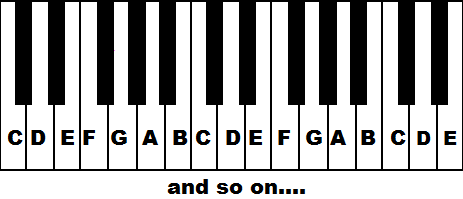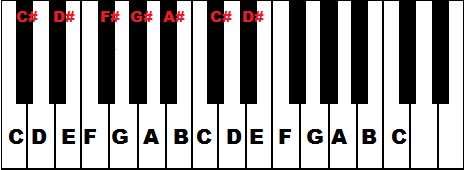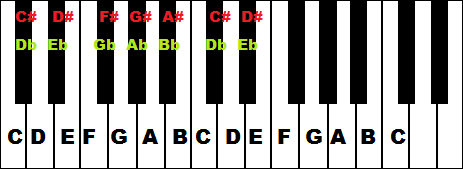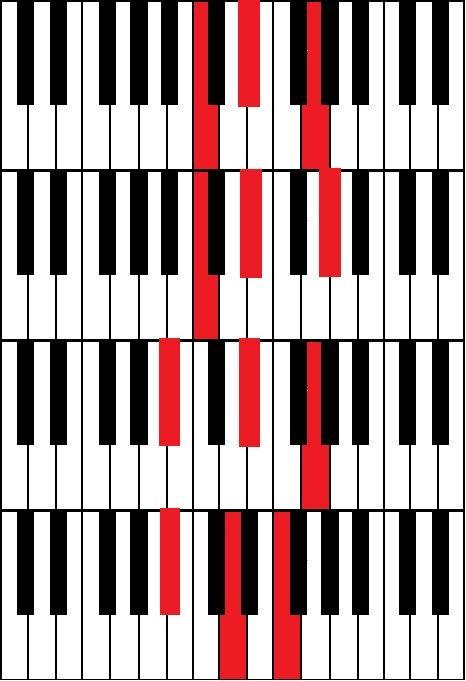No, I didn't do "Beat It" or "Billie Jean" or anything like that. I first heard "Hold My Hand" on the radio back in October, and I kind of liked it. Then, as with many other songs, I heard it more, and I liked it more. Then I heard it even more, and I REALLY liked it. You can see where I'm going with this.
I haven't done an a cappella cover since "Nothing On You" by B.O.B. back in June, so this one was a lot of fun to do!
So here it is. The result of multi-track layerings of my voice + a one-day Flipcam rental + amazing audio and video editing software + 2-3 hours of work per day over 4 days:
Saturday, February 12, 2011
Thursday, February 10, 2011
Lesson #1 - The Musical Alphabet
Welcome class! Today you will begin a wondrous journey into the cross-cultural, universal language known as music. Judging by the title of this post, you can probably deduce that this particular lesson is not intended for people with a fair amount of musical background. No sir, this is for people who look at a piano and tilt their heads in utter confusion.
So anyway, the musical alphabet is relatively simple. Do you know the English alphabet? You know, A though Z? Congrats! You already know over half of the musical alphabet (in terms of actual pitches. I'll explain that in a bit). The musical alphabet uses the following letters:
A B C D E F G
Simple, no? Let's take a look at that on the piano:

As you can see, once you get to G, you don't move up to H, nor do you start moving backwards. You simple go back to A. Because of this, think of these 7 notes of the musical alphabet more circularly rather than linearly. B is higher than A and lower than C. F is higher than E and lower than G. And G is higher than F, but lower than the next A. Two notes with the same name (e.g., two C's) but located at different places on the piano are said to be in different octaves.
Try this on a piano (if you don't have a piano or keyboard near you, use this). Play a few random notes on the piano. Take note of how different they sound. Now play the same note in different octaves (e.g., play an F, then play another F in a different spot). Even though one is higher than the other, the two sound pretty similar, don't they? That's what an octave essentially is.

**Scientifically/mathematically/nerdily speaking, if note X is an octave above note Y, then the frequency of note X is twice that of note Y (which means that the frequency of note Y is half that of note X). Remember, notes are just sound waves, which means that molecules in the air are vibrating at a certain rate. If I've lost you, then don't worry about it. It's not important for our purposes.
Now that you've got a hang of the initial 7 notes, let's figure out what those black keys are:

Ignoring the immaculate precision of MS Paint placing the notes on the keys, notice those strange symbols. What does that "#" sign mean? "C number? F number?"
'#' means 'sharp.' The black key immediately to the right of C is C#, to the right of D is D#, and so on. As you can probably guess, C# is sonically between C and D, hence the location of the black keys on the piano.
But wait! There's more!!

Oh great, now there's uppercase AND lowercase B's? Don't worry, the lowercase 'b' on the black keys means "flat." Whereas a sharp sign (#) means to raise the pitch by a half-step, a flat sign (b) means to lower the pitch of a note by half a step.
WHICH MEANS that 'C#' is the same thing as 'Db' (from a practical standpoint, not from a music theorist's perspective. We'll only worry about the practical).
"Hold on!" says you. "I see a flaw in your little theory. There's no black key between E and F, nor is there one between B and C! Explain that!!"
Well spotted, my young Padawan. Unfortunately for us, the musical deities at be had to make things rather complicated for us. The distance between any two consecutive notes on a piano (do NOT count two white keys as consecutive if there's a black key between them. Duh) is half-step, also called a semitone. Which means that the distance between two white keys is usually two semitones/two half-steps/one whole step. But the distance between E and F, as well as the distance between B and C, is only one semitone.

Whoops! Time to run to class! That's all for today. More to come eventually!
So anyway, the musical alphabet is relatively simple. Do you know the English alphabet? You know, A though Z? Congrats! You already know over half of the musical alphabet (in terms of actual pitches. I'll explain that in a bit). The musical alphabet uses the following letters:
A B C D E F G
Simple, no? Let's take a look at that on the piano:

As you can see, once you get to G, you don't move up to H, nor do you start moving backwards. You simple go back to A. Because of this, think of these 7 notes of the musical alphabet more circularly rather than linearly. B is higher than A and lower than C. F is higher than E and lower than G. And G is higher than F, but lower than the next A. Two notes with the same name (e.g., two C's) but located at different places on the piano are said to be in different octaves.
Try this on a piano (if you don't have a piano or keyboard near you, use this). Play a few random notes on the piano. Take note of how different they sound. Now play the same note in different octaves (e.g., play an F, then play another F in a different spot). Even though one is higher than the other, the two sound pretty similar, don't they? That's what an octave essentially is.

**Scientifically/mathematically/nerdily speaking, if note X is an octave above note Y, then the frequency of note X is twice that of note Y (which means that the frequency of note Y is half that of note X). Remember, notes are just sound waves, which means that molecules in the air are vibrating at a certain rate. If I've lost you, then don't worry about it. It's not important for our purposes.
Now that you've got a hang of the initial 7 notes, let's figure out what those black keys are:

Ignoring the immaculate precision of MS Paint placing the notes on the keys, notice those strange symbols. What does that "#" sign mean? "C number? F number?"
'#' means 'sharp.' The black key immediately to the right of C is C#, to the right of D is D#, and so on. As you can probably guess, C# is sonically between C and D, hence the location of the black keys on the piano.
But wait! There's more!!

Oh great, now there's uppercase AND lowercase B's? Don't worry, the lowercase 'b' on the black keys means "flat." Whereas a sharp sign (#) means to raise the pitch by a half-step, a flat sign (b) means to lower the pitch of a note by half a step.
WHICH MEANS that 'C#' is the same thing as 'Db' (from a practical standpoint, not from a music theorist's perspective. We'll only worry about the practical).
"Hold on!" says you. "I see a flaw in your little theory. There's no black key between E and F, nor is there one between B and C! Explain that!!"
Well spotted, my young Padawan. Unfortunately for us, the musical deities at be had to make things rather complicated for us. The distance between any two consecutive notes on a piano (do NOT count two white keys as consecutive if there's a black key between them. Duh) is half-step, also called a semitone. Which means that the distance between two white keys is usually two semitones/two half-steps/one whole step. But the distance between E and F, as well as the distance between B and C, is only one semitone.

Whoops! Time to run to class! That's all for today. More to come eventually!
Tuesday, February 1, 2011
Lessons For Beginners?
So for the longest time, I've been thinking about starting some series of lectures, videos, or articles with lessons for those who are new to music but want to learn. Why do I want to do this?
Suppose you ask your friend to teach you how to play the chords to a song on the guitar or piano. For example, "Apologize" by One Republic. Your friend says, "Oh that's an easy one. It's just 6-4-1-5 in Eb major."
If you a have a basic knowledge of music theory, then you probably understand what this means. You may also be pleased to know that your friend just gave you the formula for almost every successful pop song in the last 40 years.
However, if this confuses you, then your friend would probably say something like, "Just repeat C minor - Ab major - Eb major - Bb major over and over again."
Maybe now you're not as baffled. Maybe you're more perplexed than ever. If the latter is true, then maybe your friend shows you the exact keys on the piano:

There you go. Crystal clear! Delighting in the new addition to your musical repertoire, you play Apologize non-stop for about a week until you get bored with it. You then find your friend again and ask the following:
"Dude, can you teach me how to play 'Beautiful' by Akon?"

Your friend smacks his hand to his face. Any guesses why?
Probably because you essentially already know how to play that song. You just don't realize it.
And that, dear readers, is what I hope to provide. A basic understanding of how to read and understand music in the context of music that you like. I plan to provide a series of lessons of how to not only play some of your favorite songs, but how to understand what your playing and therefore learn other song much more easily.
In the meantime, here are some of my favorite music-related websites:
MusicTheory.net A huge list of comprehensive general music lessons and exercises
Virtual Keyboard Unless most other online pianos, you can actually use the keys on your computer keyboard to play the notes.
BPM Tracker Want to figure out the tempo of a song? Just tap a key on your keyboard to the beat of the song, and this nifty tool will calculate it for you.
I'll be back soon with another post, either my first lesson or something completely unrelated. In the meantime, here's something to pique your interest:
Suppose you ask your friend to teach you how to play the chords to a song on the guitar or piano. For example, "Apologize" by One Republic. Your friend says, "Oh that's an easy one. It's just 6-4-1-5 in Eb major."
If you a have a basic knowledge of music theory, then you probably understand what this means. You may also be pleased to know that your friend just gave you the formula for almost every successful pop song in the last 40 years.
However, if this confuses you, then your friend would probably say something like, "Just repeat C minor - Ab major - Eb major - Bb major over and over again."
Maybe now you're not as baffled. Maybe you're more perplexed than ever. If the latter is true, then maybe your friend shows you the exact keys on the piano:

There you go. Crystal clear! Delighting in the new addition to your musical repertoire, you play Apologize non-stop for about a week until you get bored with it. You then find your friend again and ask the following:
"Dude, can you teach me how to play 'Beautiful' by Akon?"

Your friend smacks his hand to his face. Any guesses why?
Probably because you essentially already know how to play that song. You just don't realize it.
And that, dear readers, is what I hope to provide. A basic understanding of how to read and understand music in the context of music that you like. I plan to provide a series of lessons of how to not only play some of your favorite songs, but how to understand what your playing and therefore learn other song much more easily.
In the meantime, here are some of my favorite music-related websites:
MusicTheory.net A huge list of comprehensive general music lessons and exercises
Virtual Keyboard Unless most other online pianos, you can actually use the keys on your computer keyboard to play the notes.
BPM Tracker Want to figure out the tempo of a song? Just tap a key on your keyboard to the beat of the song, and this nifty tool will calculate it for you.
I'll be back soon with another post, either my first lesson or something completely unrelated. In the meantime, here's something to pique your interest:
Subscribe to:
Posts (Atom)
